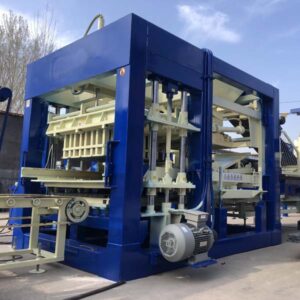
Image source Aiwei Block Machihne
Sustainable Practices in Brick and Block Production
Introduction:
The construction industry plays a significant role in shaping our built environment, but it also has a substantial impact on our natural resources and the environment. As concerns about climate change and resource depletion continue to grow, there is a pressing need for sustainable practices in all aspects of construction, including brick and block production. In this article, we will explore the importance of sustainable practices in brick and block manufacturing, examine the environmental challenges associated with traditional methods, and delve into innovative solutions and technologies that pave the way for a greener future
The Environmental Impact of Brick and Block Production:
Brick and block production has long been associated with environmental challenges due to its resource-intensive nature. Traditional manufacturing processes often involve the extraction of raw materials such as clay or cement, energy-intensive firing or curing methods, and waste generation. These practices contribute to deforestation, greenhouse gas emissions, water pollution, and depletion of non-renewable resources.
The Benefits of Sustainable Brick and Block Production:
Implementing sustainable practices in brick and block production offers numerous benefits for both the environment and the industry itself. By embracing sustainability, manufacturers can reduce their ecological footprint, improve resource efficiency, enhance product quality, and achieve long-term cost savings. Sustainable practices also align with changing market demands and consumer preferences for eco-friendly construction materials.
Sustainable Raw Materials:
One crucial aspect of sustainable brick and block production is the choice of raw materials. Alternative materials like fly ash, slag, and recycled aggregates can be used as partial replacements for traditional materials, reducing the need for resource extraction and waste generation. We will explore the properties, benefits, and challenges associated with these alternative materials and highlight successful case studies.
Energy Efficiency and Renewable Energy Integration:
Energy consumption during brick and block manufacturing is a significant contributor to the industry’s environmental impact. However, sustainable practices emphasize energy efficiency measures and the integration of renewable energy sources. We will discuss innovative technologies such as energy-efficient kilns, solar-powered manufacturing processes, and heat recovery systems, showcasing how they can significantly reduce energy consumption and emissions.
Waste Reduction and Recycling:
Water is a valuable resource that often gets overlooked in brick and block production. Sustainable practices focus on water conservation measures, such as water recycling systems, rainwater harvesting, and efficient irrigation techniques. Additionally, pollution prevention methods, including proper wastewater management and the use of eco-friendly additives, can help minimize water pollution.
Life Cycle Assessment and Green Building Certifications:
To assess the overall sustainability performance of brick and block products, life cycle assessment (LCA) methodologies provide valuable insights. LCA considers the environmental impacts throughout the product’s life cycle, from raw material extraction to disposal. Furthermore, green building certifications like LEED (Leadership in Energy and Environmental Design) and BREEAM (Building Research Establishment Environmental Assessment Method) encourage the use of sustainable construction materials, including bricks and blocks. We will discuss how LCA and green building certifications play a crucial role in promoting sustainable practices.
Conclusion:
Sustainable practices in brick and block production are essential for minimizing the environmental impact of the construction industry. By embracing alternative raw materials, improving energy efficiency, reducing waste generation, conserving water, and adopting life cycle assessment methodologies, manufacturers can contribute to a greener future. As awareness of sustainability grows and regulations become more stringent, it is crucial for the industry to prioritize and invest in sustainable practices. By doing so, we can build a more sustainable and resilient future while meeting the demands of a rapidly evolving construction landscape.
Introduction:
Brick and block production is a vital component of the construction industry, providing essential materials for building structures worldwide. However, traditional manufacturing processes often have significant environmental impacts, including the depletion of natural resources, high energy consumption, and excessive waste generation. To address these challenges and build a greener future, the adoption of sustainable practices in brick and block production is crucial. This article aims to explore various sustainable practices that can be implemented in the manufacturing process, highlighting their environmental benefits and economic feasibility.
Use of Recycled Materials
One key sustainable practice in brick and block production is the incorporation of recycled materials. Instead of solely relying on virgin raw materials, manufacturers can utilize waste materials such as crushed concrete, fly ash, and slag as partial replacements for traditional aggregates. This not only reduces the demand for natural resources but also diverts waste from landfills. The article delves into different types of recycled materials used in the production of bricks and blocks, their properties, and their impact on the final product’s quality and performance.
Energy-Efficient Technologies
Another crucial aspect of sustainable brick and block production is the adoption of energy-efficient technologies. Traditional firing methods in brick manufacturing consume significant amounts of energy and release greenhouse gases. However, modern kiln technologies, such as tunnel kilns, Hoffman kilns, and hybrid kilns, offer improved energy efficiency and reduced emissions. The article explores these advanced kiln technologies, their benefits, and their potential for optimizing energy consumption and minimizing environmental impact.
Conclusion
Sustainable practices in brick and block production are essential for mitigating environmental impacts, conserving resources, and building a greener future. The adoption of recycled materials, energy-efficient technologies, waste reduction and recycling, water conservation, and life cycle assessments can significantly contribute to sustainable development in the industry. By implementing these practices, manufacturers can not only reduce their environmental footprint but also enhance their reputation, comply with regulatory requirements, and meet the growing demand for environmentally conscious construction materials. Embracing sustainability in brick and block production is a step towards a more resilient and sustainable construction industry
